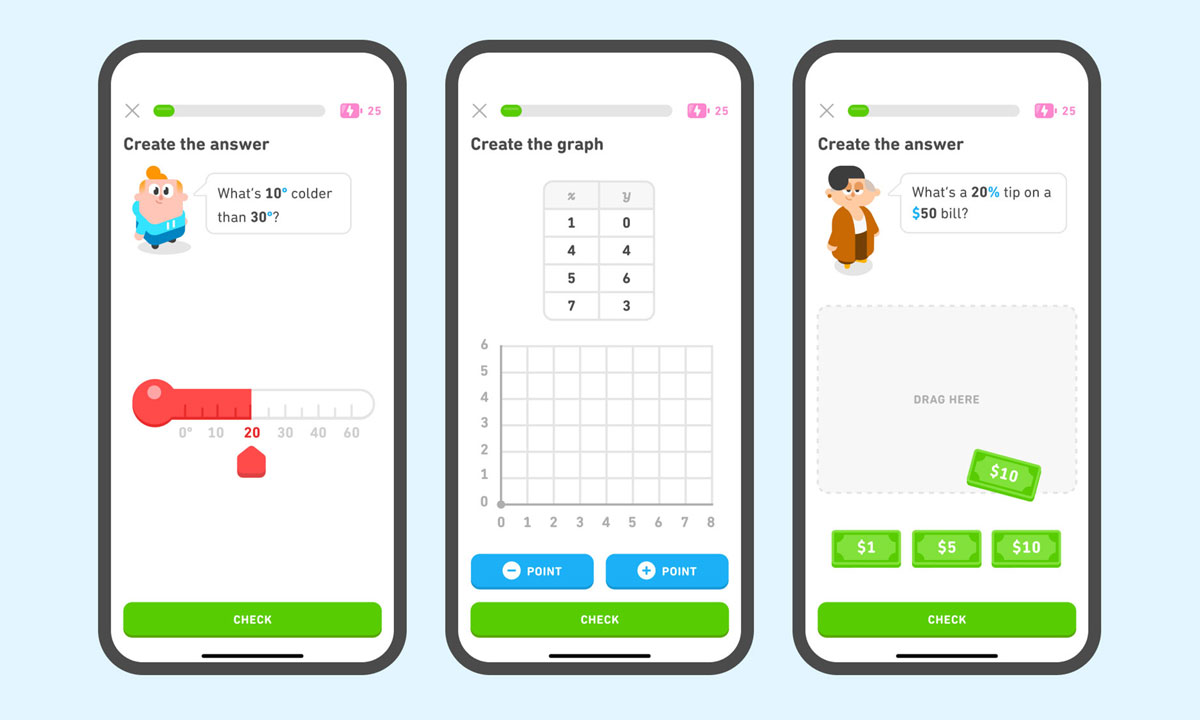Language Learning App Giant Duolingo Thinks It Can Conquer Math, Too
Duolingo’s name recognition could be a key asset fueling its expansion into a tough subject where many already offer a gamified learning approach.

Duolingo, a quick-and-easy learning app that boasts more than 128 million monthly active users worldwide — mostly for its language offerings — has expanded into mathematics with elementary and middle school lessons aligned to the Common Core standards.
The Pittsburgh-based company is one of many — including Prodigy, Splash Learn, DragonBox, IXL and Khan Academy Kids — that provide instruction for children and adults. But the language phenom hopes its broader popularity will help it gain traction in a complex space.
“Duolingo certainly arrives late to the party, but their brand recognition, UX design expertise and enormous user base give them a unique advantage,” said Paul Darvasi, CEO and co-founder of Gold Bug Interactive, a Montreal-based company with more than 15 years of experience creating learning games. “Personally, I feel math is often taught out of context. Students learn formulas and procedures, but as they get older they rarely know how they will be applied. I believe games and simulations will be able to better connect math to the real world.”
Duolingo, the most downloaded language learning app in the world, won’t disclose the exact number of users for its math offering, launched in August 2022, but company spokeswoman Monica Earle said it’s in the millions. She said, too, the application’s creators hope it will help alleviate math anxiety, a common phenomenon among children and adults.
Duolingo’s current math offerings span third grade through early middle school. Samantha Siegel, a company software engineer who spearheaded the math course’s development, said it started with third graders because of the critical lessons taught at that level.
“If you don’t understand how fractions work, it can predict your math performance and proficiency for the rest of your education career,” Siegel said.
She said the company uses real-world problems to further students’ comprehension of what might otherwise seem like abstract concepts.
“We do a lot with implicit learning … you learn by doing,” she said. “We have developed a really proven and unique way of approaching education and packaging it in a really fun way. Why shouldn’t we be the one to apply this to other subjects?”
American students have struggled with mathematics for decades. The Common Core, a controversial set of academic standards rolled out in 2010, was meant to correct the unevenness in how the subject was taught across the nation and deepen students’ understanding. It was met with sharp disdain from teachers, parents and students.
Despite the derision, it became a symbol of academic rigor and dozens of states continue to use Common Core math. But even with the new standards, American students continued to flail: Test scores persistently lagged for most, though bright spots have emerged in recent months.
A 2024 Urban Institute study only reinforced the subject’s importance. It found that increasing math scores helps deliver stronger long-term returns for students — especially related to earnings — compared to reading.
What’s less obvious, at least to some, is the value of game-based approaches to learning this challenging subject. Critics worry about what they say is Duolingo’s skin-deep approach.
Keith Devlin, a mathematician and Stanford University professor emeritus, knows repetitive practice is valuable in learning almost anything and that video games and interactive software in general are excellent at keeping people engaged. He’s not as confident, however, in the idea that these applications will create mathematical thinkers.

“The real question is, do games produce better ability to solve a mathematical problem that is more than a basic skill? For the majority of games, the answer is no,” he said. “They often do result in students having a more positive attitude to math — and that’s a plus.”
But they don’t teach users how to solve math problems that require a train of thought, he said.
“Where they can fall short is in the tendency to focus too heavily on rote practice or gamified repetition without enough conceptual depth,” Gold Bug Interactive’s Darvasi said. “Math understanding requires more than speed and accuracy; it needs problem-solving, reasoning and connections to real-world contexts. Apps that fail to integrate those richer experiences risk reinforcing procedural knowledge without deep comprehension.”
Darvasi said, too, that digital math learning can become isolating if it isn’t paired with collaborative, discussion-based problem-solving — like the kind found in traditional classrooms.
“However, these are temporary setbacks,” he said in assessing current online offerings from multiple companies. “With the latest tools in adaptive learning, thoughtful game design, and technology that can generate fresh challenges on the fly, the path is opening for math to be taught in ways that are engaging, meaningful, and tailored to the learner.”
Duolingo Math’s target audience, spokeswoman Earle said, is students who struggle with the subject and those who enjoy it enough to do it for fun. Cartoon figures and colorful graphics help guide users through the math problems, offering encouragement along the way.
Roughly 90% of users access Duolingo, which also runs programs off its website, for free. Others pay either $12.99 a month or $95.99 a year for Super Duolingo, which avoids ads and allows for unlimited practice. A second level, Duolingo Max, costs $29.99 a month or $167.99 a year and offers enhanced, generative-AI-powered conversation features.
Despite some pushback from users about the limitations of the language learning tool and a recent kerfuffle over how much AI would shape the product, Duolingo’s reported second-quarter earnings for 2025 were $252.3 million, up from $178.3 million a year ago.
Nicole Paxton, principal of Mountain Vista Community School in Colorado Springs, said her school relies upon Math Catalyst, a teacher-led, concept-focused program from Great Minds. It is not a computer-based game, but “a structured set of mini-lessons and practice activities that target specific learning gaps and build strong mathematical reasoning”, she said.

“If used as a supplement at home, a program like Duolingo Math could be helpful for fluency and fact practice, but it would not replace the intentional, standards-based support students receive through Math Catalyst,” Paxton said.
Earle said the program also allows for personalization using machine learning to tailor each lesson. Once it identifies a weakness in students’ understanding, it will present them with these same problems until they can solve them.
But the main purpose of the venture, software engineer Siegel said, is to make math feel fun.
“Duolingo is really delightful,” she said. “That’s our bread and butter.”
Get stories like these delivered straight to your inbox. Sign up for The 74 Newsletter

;)
